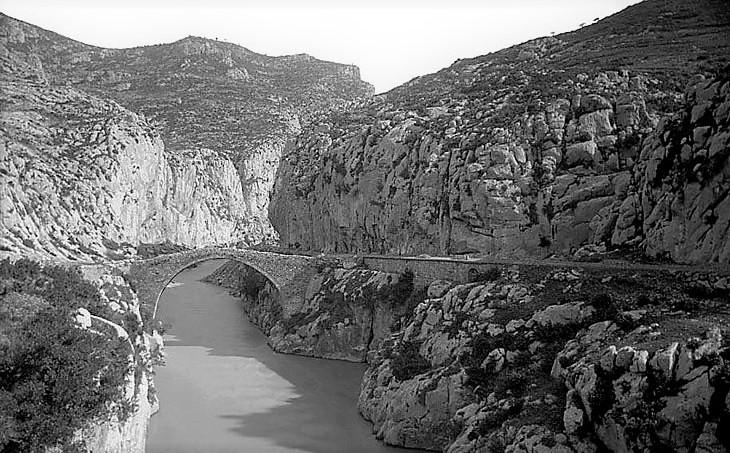ELS TRES PONTS. LA TORRE, EL DIABLE I L’ESCALA (II PART AND END)
The mythical place of the Segre River at the gates of the Pyrenees
In 1685, General Ambrosio Borsano described the dangerous path as follows: “Half a league before reaching the place [Organyà], I crossed the Segre River three times on three stone bridges, which are between two very rough mountains and there are only two paths, one of which can barely be walked by a man and the other by a horse.”
The first bridge was named La Torre. It received this name because it was built under a fortified tower. This bridge was destroyed and later rebuilt in 1331. General Ambrosio Borsano continued his description by stating the following: “At the first of these three bridges, there is a very old tower, which at the time when the Seu de Urgel was in the hands of France, they had this tower occupied to prevent anyone from passing along that road without being searched.”
This bridge held out until the Civil War and was blown up in 1936 by the Republican army. The second bridge, the Devil’s Bridge, is named after the fact because Bishop Ermengol built it during the day and the devil demolished it at night, according to legend. Until one night the bishop caught the devil and tried to tie him to one of the rocks above the bridge, an event that caused what is known as La Pixarrada del Diable, which the devil did to demolish the bridge once again. This can be seen today engraved in the rock.
The bridge has two superimposed arches, because two were built, presumably due to their instability and fragility in such a rugged and rugged territory. On the left bank of the bridge, you can read today the following sentence: “on May 24, 1853 Segre arrived here” due to a great flood in this year, as happened later in the years 1907 and 1982, reaching 2700 m3/sec in the latter. The bridge was intended to be fortified at the end of the 17th century but was finally destroyed in the third Carlist war by General Martinez Campos.
The third bridge, the Escala bridge, crossed the river on the right bank where the road would lead to Organyà until 1685. Later, after suffering several collapses, they decided to replace it with a wooden lever, as documented in 1716, then receiving the name of Palancó. This bridge was fortified by the Baron of Preu by building a fortified tower. Today the two abutments or supports, one on each side, of the arch of the bridge are preserved.
This is the true story of an untamed gorge between the bed of a mythical river, where man has tried to shape it since the beginning of time in order to travel across it. We have written records from the time of Hannibal to Julius Caesar himself and his legions, who crossed the infamous gorge trying to build a bridleway to facilitate the passage of his legions in a totally wild territory, where nature was merciless with man. It was not until the 10th century when Bishop Ermengol decided to build a bridleway suitable for travellers in that harsh time, to provide it with three bridges that would allow them to cross both banks of the river, since the bridleway ran from one bank to the other of the Segre along the precipices and cliffs on both banks of the river that made walking impossible; hence the construction of the three bridges.
Today, the site can be visited, easily accessed from Organyà, through the two recently built tunnels that cross the mountain without the need to pass along the old road next to the gorge. Naturally, fishing is still good, although dangerous due to the large increases in the flow of the Segre coming from the water of the Andorran lakes that release water daily, suddenly increasing the flow of the river in a very dangerous way, doubling and tripling the initial flow. It is a place of deep pools and rapid currents dotted with enormous limestone rocks that make its journey a real adventure only recommended at certain times of the year, if the weather and the rains of the valleys of the Pyrenees allow it and always accompanied by an expert who knows this untamed place.
The place, compared to old photos and engravings, is intact and presents the same challenging and fierce appearance of two thousand years ago. Of the three bridges and the bridle path with “els pontarrons” only sufficiently eloquent remains remain to be able to recreate and in a certain way relive those past millennia.
~Carles V.

